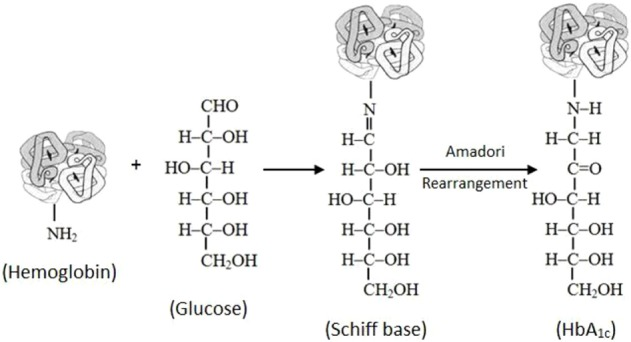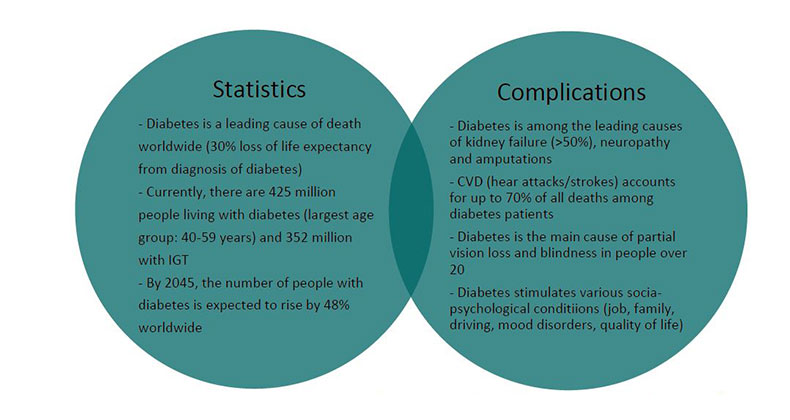HbA1c - A reliable biomarker for the diagnosis and prognosis of Diabetes
The Role of HbA1c Biomarker in Diabetes Management
Introduction:
Diabetes is a global endemic with rapidly increasing prevalence in both developing and developed countries. The American Diabetes Association has recommended glycated hemoglobin (HbA1c) as a possible substitute to fasting blood glucose for diagnosis of diabetes. HbA1c is an important indicator of long-term glycemic control with the ability to reflect the cumulative glycemic history of the preceding two to three months. HbA1c not only provides a reliable measure of chronic hyperglycemia but also correlates well with the risk of long-term diabetes complications.
Background:
Analysis of glycated hemoglobin (HbA1c) in blood provides evidence about an individual’s average blood glucose levels during the previous two to three months, which is the predicted half-life of Red Blood Cells (RBCs).
 Image 1.Formation of glycated hemoglobin (HbA1c) from the binding of glucose to hemoglobin
Image 1.Formation of glycated hemoglobin (HbA1c) from the binding of glucose to hemoglobin
Every seven seconds, diabetes is the cause of deaths, worldwide.
An elevated level of HbA1c has been identified as a significant risk factor for cardiovascular diseases and stroke in subjects who may have diabetes.
 International Diabetes Federation (IDF) Diabetes Atlas, 8th edn. Brussels, Belgium: International Diabetes Federation 2017. http://www.diabetesatlas.org
International Diabetes Federation (IDF) Diabetes Atlas, 8th edn. Brussels, Belgium: International Diabetes Federation 2017. http://www.diabetesatlas.org
Discussions:
A community-based population study on 11,092 non-diabetic patients, found that elevated HbA1c level was strongly associated with the risk of cardiovascular disease and mortality. High levels of HbA1c were associated with an increased risk of recurrence of atrial tachyarrhythmia in patients with type 2 DM and paroxysmal atrial fibrillation undergoing catheter ablation. Even an increase of 1% in HbA1c concentration was associated with about 30% increase in all-cause mortality and 40% increase in cardiovascular or ischemic heart disease mortality, among individuals with diabetes. Whereas reducing the HbA1c level by 0.2% could lower the mortality by 10%. Improving glycemic control in patients with type 2 diabetes may be more important than treating dyslipidemia for the prevention of both microvascular and macrovascular complications.
Diagnostic Significance:
The ADA (Americal Diabetes Association) has recently recommended HbA1c with a cut-point ≥6.5% for diagnosing diabetes as an alternative to fasting plasma glucose (FPG ≥7.0 mmol/L) -based criteria. The levels of HbA1c are strongly correlated with FPG. FPG, 2-hour post-glucose load plasma glucose, and oral glucose tolerance tests are recommended for the diagnosis of diabetes only if HbA1c testing is not possible due to unavailability of the assay. HbA1c provides a reliable measure of chronic glycemia and correlates well with the risk of long-term diabetes complications, so that it is currently considered the test of choice for monitoring and chronic management of diabetes.
| Blood Glucose |
Status |
HbA1c |
| mmol/L |
mg/dL |
|
% |
mmol/mol |
| 5.4 |
97 |
Normal |
5 |
31 |
| 7 |
126 |
Normal |
6 |
42 |
| 8.6 |
155 |
Pre-Diabetes |
7 |
53 |
| 10.2 |
184 |
Diabetes |
8 |
64 |
| 11.8 |
212 |
Diabetes |
9 |
75 |
| 13.4 |
241 |
Diabetes |
10 |
86 |
| 14.9 |
268 |
Diabetes |
11 |
97 |
| 16.5 |
297 |
Diabetes |
12 |
108 |
Methods in estimation of HbA1c:
- HPLC
- Immunoturbidimetric
- Enzymatic
- Electrophoresis
- POCT
- Boronate affinity
 Erba HbA1c kit
Erba HbA1c kit
Advantages of Erba HbA1c kit:
- Most Accurate
- Greater Sensitivity of 3.3% with advanced Immuno Turbidimetric Method
- 4X Longer Shelf Life (24 months @ 2-8Deg.C & 1 Month on Board)
- 5X Longer Calibration Stability (30 days)
- 99 % Correlation with HPLC
- Linearity of 16 % (15.7%) as per Industry Standards
- Standardised to IFCC reference method
- Convenient Pack Size(2 x 15/2 x 5/5 x 0.5/(2 x 44ml) & 1 x 15/1 x 5/5 x 0.5/(1 x 44 ml)
- Free Calibrator with Kit
- Easy to use
- Adaptable to all open Fully Auto Analyzers and Semiauto Analyzers.
References:
- World Health Organization (WHO) Use of Glycated Haemoglobin (HbA1c) in the Diagnosis of Diabetes Mellitus Abbreviated Report of a WHO Consultation. Geneva: WHO; 2011.
- Koenig RJ, Peterson CM, Jones RL, Saudek C, Lehrman M, Cerami A. Correlation of glucose regulation and hemoglobin AIc in diabetes mellitus. N Engl J Med. 1976;295:417–20.
- American Diabetes Association (ADA) Standards of medical care in diabetes. Diabetes Care. 2014;37:S14–80. [PubMed] [Google Scholar]
- International Diabetes Federation (IDF) 2015. Available from: www.idf.org
- Herman WH, Fajans SS. Hemoglobin A1c for the diagnosis of diabetes: practical considerations. Pol Arch Med Wewn. 2010120:37–40.